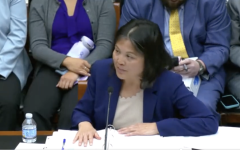
Peninsula train. (Photo: Public Domain)
National Opposition to CARB Rail Rule Growing
CARB is demanding that railroads adopt a technology that does not exist
By Thomas Buckley, June 17, 2024 3:42 pm
The California Air Resource Board (CARB), never a shrinking violet when it comes to regulating things out of existence, is running into national opposition in its bid to force railroads to go to zero-emission locomotives.
Last fall, CARB approved its “In-Use Locomotive Regulation” that would force railroads to stop using any locomotive it has that is more than 23 years old and replace said locomotive with a zero-emission version. In order to make this new rule stick, CARB needs a special waiver from the Environmental Protection Agency because railroads – since nearly their inception – have been largely governed by federal, not state, regulations.
But over the past few weeks – as the EPA considers the request – the agency has been flooded with statements of opposition from railroad unions, business groups, the railroads themselves, and even other local, state, and federal government agencies.
At issue are not just the impacts the new rule would have in California but around the country.
At a hearing of the the House Investigations and Oversight subcommittee of the Committee on Science, Space, and Technology, members of Congress and industry leaders testified that the new rule would have devastating impacts on the railroad industry, the national supply chain, the price of goods, and even the environment, the protection of which CARB claims is reason for the rule in the first place.
“It is an overreach of epic proportions on the part of CARB…that is an existential threat to our members,” said Chuck Baker, the president of the American Short Line and Regional Railroad Association (note –Baker used the term ‘existential threat’ correctly.)
The regulation, if approved, would force railroads to stop using any locomotive it has that is more than 23 years old and replace said locomotive with a zero-emission (Tier 5) version.
Until then – the countdown starts in 2030 – a railroad can either try to buy what are called “Tier 4” locomotives – tier 4 locomotives and other types of tier 4 engines are meant to reduce particulate matter in the air and nitrogen oxide at the ground level, among other things – or it can pile money into a “spending account” to “fund their own trust account based on the emissions created by their locomotive operations in California. The dirtier the locomotive, the more funds must be set aside.”
A few problems with this: first, “Tier 5” locomotives simply do not exist and, industry experts say, will not practicably available by the final 2035 deadline.
Second, the vast majority of locomotives operating today – especially on the smaller local “short lines” which buy them used from the bigger railroads – are well over 23 years old. The typical lifespan for a locomotive is between 40 and 50 years, Ian Jeffries, president of the American Railroad Association, testified.
Locomotives are like airplanes, Jeffries said – they are bought with the intent to use them for quite some time to be able to amortize the $4-5 million cost.
And CARB wants them to be thrown away (or, in theory, a locomotive could trail 20 battery cars instead…if they existed.)
The national groups are weighing in on the matter because what starts in California does not stay in California. Baker said about a dozen other states typically follow CARB rules and that would make a mockery of the idea of freely moving interstate commerce.
“A California rule is de facto a national rule,” Baker said.
“There is no such thing as a one-state railroad regulation,” Jeffries added, adding that he and his group strongly believe that CARB cannot even legally impose such a rule even with an EPA waiver.
The rule – if allowed – would create a ripple (tsunami?) effect across the country, in part because 70% of the locomotives the big railroads own spend at least part of their time every year in California, moving freight to and from the ports in LA, Long Beach, and Oakland.
The possibility of having to switch locomotives at state lines is very real – this would add costs and create delays, costs and delays that would have to be covered by the end user, i.e. you.
There is also the issue of environmental impacts. A train can move a ton of goods about 450 miles on a dingle gallon of diesel fuel and each freight car carries the equivalent amount of stuff as three or four trucks. Fewer trains means more – a lot more – trucks on the roads which would actually increase the amount of so-called greenhouse gases emitted.
In southern California specifically, the rule would have a catastrophic impact on regional highways. Currently, BNSF is building an intermodal center in Barstow so many of the containers that are on freeways like the I-10 now could be moved off on to trains. If the rule goes through, noted Jeffries and subcommittee chair Rep. Jay Obernolte – who represents Barstow and parts of LA and Kern counties – the railroad would pull the plug on the facility because it would be impossible to operate. That’s thousands of less jobs, said Obernolte, and thousands of more trucks clogging the freeways. (note – even though it could mean more business for them, trucking industry associations are against the idea.)
Democrats on the committee said the new rule is about protecting public health, particularly in “front-line” neighborhoods near rail lines.
“The ‘environmental justice’ communities must be centered” in any discussion of the issue, said Rep. Valeri Foushee (D-NC.)
Just in case you are not up with the latest wokebureaucrat jargon, an “environmental justice community” is “A neighborhood or community, composed predominantly of persons of color or a substantial proportion of persons below the poverty line, that is subjected to a disproportionate burden of environmental hazards and/or experiences a significantly reduced quality of life relative to surrounding or comparative communities.”
Foushee and Alan Abbs of the Bay Area Air Quality Management District said the current environmental impact – more particulates and nitrous oxides than typical greenhouse gas – of the trains causes thousands of deaths each year, even though rail makes up 0.8% of all greenhouse gases created in the country.
Both added that the regulation would lead to a “90% drop” in cancer cases in impacted communities. (That sounds, um, high, but feel free to go through CARB’s numbers on that claim here.)
The EPA has not set a timeframe for its decision.
And just to stress this again: CARB is demanding that railroads adopt a technology that does not exist and would not exist at a large enough scale by the deadline for any company to be able to comply.
And it would increase air pollution.
And cost thousands of jobs.
And disrupt the national supply chain.
And increase prices.
Thanks, CARB.
- Benefit Fraud Problems and Solutions - November 7, 2024
- A Little Exit Poll - November 5, 2024
- Tomorrow’s Headlines Today! - November 5, 2024





The “environmental justice community” composed of self-proclaimed perennial “victims” of white supremacy will actually be the primary victims of this lunacy. They will be forced to purchase hyper inflated essential goods being transported by electric trucks whose technology hasn’t been perfected and for which there is no viable electric power grid. However, because of environmental justice, when they their last breath due to starvation they will know it is clean air courtesy of California’s Marxists.
Hey, this is California, Newsom’s “nation-state” and his unelected minions are doing the devil’s work of setting mandates that are pipe-dreams of their “green” agenda funders…
Do a little digging, and I’ll bet you’ll find that China’s BYD is working on developing electric TRAINS, just like their (failed) electric BUSES that I’m sure Newsom & Co. got a nice financial kickback on….
Gavvie learned well from Auntie Nancy’s example of how to get rich from a cushy government gig…. pass the laws and profit from their implementation, regardless of the economic impacts to the constituents….
This central committee planing (CCP), that comes from a one party state, I am totally against, with that said.
The technology does exist, though zero emission not, electricity has got to come from somewhere.
Our rail system uses diesel electric, because I guess that engineers figured that electric is more efficient.
I worked in the open pit mines in Nevada, and the BIG haul trucks used over head electricity coming out of the pit, then switched to diesel up top.
Europe uses over head electric trains for a long time….BUT….The infrastructure has been in place for well over a hundred years.
In order for the US to do that would up end our economy.
I use a measure, If you can get a train to get over the Sierras, or the Rockies on electric, or a airplane over the Atlantic, then we have achieved that technology.
A gallon of fossil fuel has more ‘practical’ energy then anything other than uranium.
That comes from the book, Physics for future Presidents, by Richard Muller…a good read.